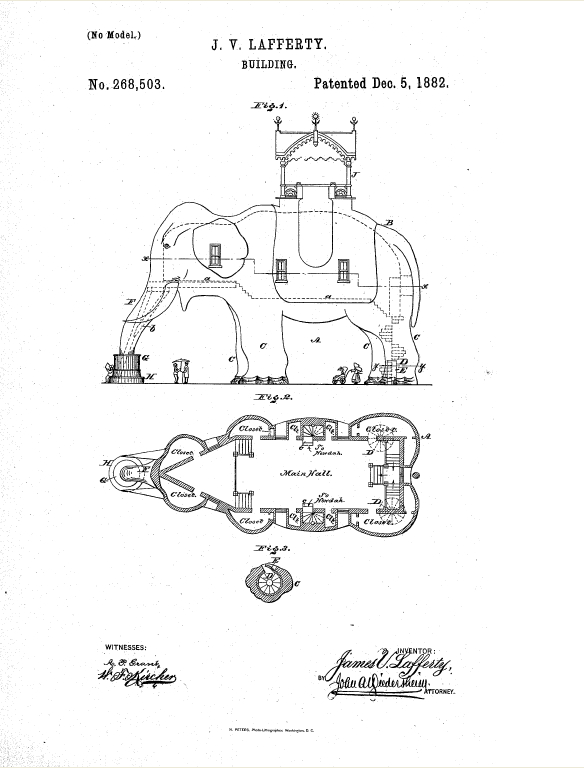Lucy the Elephant
Contents |
[edit] Introduction
Lucy the Elephant, originally named Elephant Bazaar, is a six storey building in the seaside town of Margate, New Jersey. The structure was built by James V. Lafferty, Jr in 1882 to attract economic development to the area.
Lafferty would invite real estate investors into Lucy’s uppermost carriage (or howdah) to enjoy the panoramic view of nearby Atlantic City and the Atlantic Ocean. He would also point out surrounding plots of land that could be purchased by potential investors.
[edit] Becoming Lucy
Philadelphia architects William Free and J. Mason Kirby were hired to design the structure based on Lafferty’s patented plans. The completed structure required roughly one million pieces of timber and was covered in 12,000 square feet of tin. It stands 19.7m high, 18.3m long and 5.5m wide and weighs approximately 90 tons.
The Elephant Bazaar was given the name ‘Lucy’ after it was sold in 1887 to Anton Gertzen of Philadelphia. Over the years, Lucy was used as a restaurant, office building, cottage and pub (which closed during Prohibition).
[edit] Lucy today
Time had taken its toll on Lucy, and in the 1960s, she was scheduled for demolition. A campaign to save her was successful, and she was refurbished and moved to a location a short distance from her original site. She was hit by a lightning strike in 2006 that discoloured her tusks.
Lucy has continued to attract tourists to the area. In 2020, Lucy became an Airbnb property (the only National Historic Landmark available through the hosting service) for a limited number of stays. Even when booked, Lucy is still open for tours.
[edit] Related articles on Designing Buildings Wiki
Featured articles and news
Delivering for tenants; National Retrofit Hub
New report offers recommendations to strengthen energy efficiency standards to protect private renters.
Government consultations for the summer of 2025
A year of Labour, past and present consultations on the environment, the built environment, training and tax.
CMA competitiveness probe of major housing developers
100 million affordable housing contributions committed with further consultation published.
Homes England supports Greencore Homes
42 new build affordable sustainable homes in Oxfordshire.
Zero carbon social housing: unlocking brownfield potential
Seven ZEDpod strategies for brownfield housing success.
CIOB report; a blueprint for SDGs and the built environment
Pairing the Sustainable Development Goals with projects.
Types, tests, standards and fires relating to external cladding
Brief descriptions with an extensive list of fires for review.
Latest Build UK Building Safety Regime explainer published
Key elements in one short, now updated document.
UKGBC launch the UK Climate Resilience Roadmap
First guidance of its kind on direct climate impacts for the built environment and how it can adapt.
CLC Health, Safety and Wellbeing Strategy 2025
Launched by the Minister for Industry to look at fatalities on site, improving mental health and other issues.
One of the most impressive Victorian architects. Book review.
Common Assessment Standard now with building safety
New CAS update now includes mandatory building safety questions.
RTPI leader to become new CIOB Chief Executive Officer
Dr Victoria Hills MRTPI, FICE to take over after Caroline Gumble’s departure.
Social and affordable housing, a long term plan for delivery
The “Delivering a Decade of Renewal for Social and Affordable Housing” strategy sets out future path.
A change to adoptive architecture
Effects of global weather warming on architectural detailing, material choice and human interaction.
The proposed publicly owned and backed subsidiary of Homes England, to facilitate new homes.
How big is the problem and what can we do to mitigate the effects?
Overheating guidance and tools for building designers
A number of cool guides to help with the heat.
The UK's Modern Industrial Strategy: A 10 year plan
Previous consultation criticism, current key elements and general support with some persisting reservations.
Building Safety Regulator reforms
New roles, new staff and a new fast track service pave the way for a single construction regulator.




























